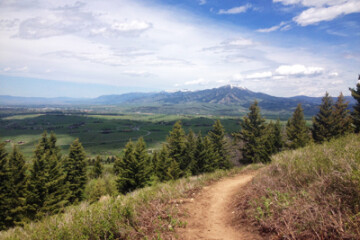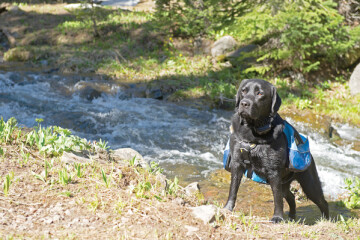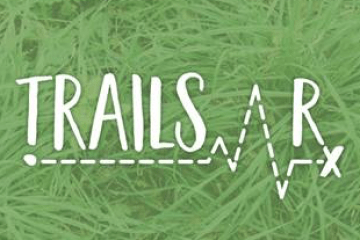Being a Trail Ambassador

The College M is one of the most popular trailheads in the Gallatin Valley, and parking is at a premium this beautiful Saturday afternoon in July as I set up a Trail Ambassador table near the trailhead kiosk. As soon as I place a water dispenser and Dixie cups on the table, hikers coming down the southern flanks of Mount Baldy avail themselves of the opportunity to rehydrate – and many opt to stick around and chat before heading to the parking lot.
Hikers and runners of all shapes, sizes and ages file past the table, which also contains bug spray, dog waste bags and leashes. Dog owners are asked, “Do you need to grab some poop bags?” as their pups bound excitedly up the trail.
Being a Trail Ambassador keeps me connected to fellow trail users. When I moved to Bozeman 16 years ago, it was uncommon for two hikers to pass one another without a smile and a greeting. I think we’ve slipped a bit in recent years, so I enjoy serving as a catalyst for discussion and connection on our trails. The Trail Ambassador table serves as a conversation area where “community” can be formed among trail users who share experiences with one another. After a while this “community” is threatening to block trailhead access, so I excuse myself to do some trailhead maintenance.
My goals as a Trail Ambassador are to be useful, helpful and engaging. When trail users see you re-stocking toilet paper and dog waste bag rolls, picking up trash in the parking lot, scooping dog poop, trimming branches and pulling weeds, you are seen as a resource rather than a “trail compliance officer.” I’m constantly surprised by how many folks go out of their way to say “thank you” when they see me performing clean-up tasks at the trailhead or along the trail – and that opens the door for conversations about trail etiquette, trail conditions, etc. I let them know that I have maps, a first aid kit and a host of other hand-outs and reference items if they ever find themselves in need of such resources.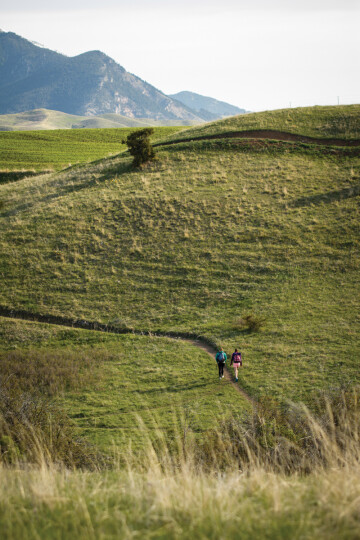
As I’m cutting a particularly nasty patch of burdock at the trailhead and stuffing the stalks and prickly seed heads into a garbage bag, a young couple approaches hand in hand. “How’s it going?” I ask. A huge smile spreads across the man’s face, “I’m walking on air. I just asked her to marry me up at the M. And she said yes! You’re the first person we’ve told the news to.” I feel honored. Had I not been on the trail that day, I would’ve missed that.
When I first arrived at the trailhead, I encountered a family of four (mom, dad, 2 teenage sons) who asked me whether they should take the “most popular trail” or the “steep trail” up to the M. They are visiting from Florida and this is going to be their “big bucket list hike” that weekend. After a quick glance at their footwear and noticing that they aren’t carrying water bottles, I advise them to take the less steep trail. They seemed a bit disappointed, so I reminded them that they are over 5,000 feet above sea level and getting up to the M will still be challenging.
A mother and college-age daughter emerge from the trail, and the mom reports, with pride, between deep breaths, “I didn’t think I could keep up with her, but we made it to the big lookout about a mile above the M.” I inform them that the popular name for the lookout is Yoga Rock. The daughter looks at her mom with pride and declares, “I think they should rename it Mom Rock, because my mom rocks.” She tosses the Dixie cup in the trash bucket and walks toward the parking lot. Her mother turns to me and raises both fists in the victory pose. Had I not been on the trail that day, I would’ve missed that.
One of the reasons I joined the Trail Ambassador program was to try to make a positive impact on the way dog owners use – and sometimes abuse – our local trail system. As a dog owner, I don’t want to lose the privilege of being able to hike, run and bike with my dogs beside me: it’s one of my greatest joys. Unfortunately, trailheads are littered with dog waste and leash regulations are widely ignored on our local trails. My goal is to help change these behaviors in both subtle and direct ways. I always take time to scoop dog poop – with bucket and bright red scooper – at trailheads when I’m wearing my Trail Ambassador shirt and hat. “It’s a shame you have to do that,” is the typical response from passers-by. “Dog owners should be doing that themselves.”
Dog owners often make a point of telling me that they not only pick up their own dog’s waste, but they also clean up other dog’s poo when they encounter it on the trail. Every dog owner who passes me assures me that they have a poop bag, or they gladly take the bags I offer. With all of these assurances of compliance and model behavior from dog owners –why is there so much dog poo stinking up every area trailhead? Why is most of it within 100 yards of a dog waste station? Why do I find a fresh poo pile just 20 yards from the Trail Ambassador table near the end of my two-hour shift after only encountering those who assure me they are “responsible dog owners?” Clearly, more work needs to be done.
As I’m about to break down the Trail Ambassador table, I see the four Floridians heading toward me. They have the same bright smiles on their sweaty faces as the newly-engaged couple displayed. They each pour a cup of water and slump heavily onto the trailhead bench. After thanking me for steering them away from the steep trail, they recount their experience, beaming with pride.
Two trail-runners in their mid-thirties sprint down the steep trail, then stop to refill empty water bottles while gasping for air. They explain that they’ve just completed the Bridger Ridge Run course in its entirety, having run and speed-hiked all the way from Fairy Lake. One of the Floridian teens asks, “Is Fairy Lake further up than the M? We all made it up to the M – no problem!” One of the exhausted trail-runners pats the young man on the shoulder and says, “Good job, man. Good job.” Had I not been on the trail that day, I would’ve missed that.
It seems to be more and more clear that trails are good for your health. There is a slew of research to support that regular trail walks can have real measurable effects on rates of chronic diseases. Our nation is struggling with obesity at higher rates than ever. 7 out of 10 deaths in the US are caused by chronic diseases such as pulmonary disease, heart disease, diabetes, and cancer. Exercise can help with that. And fresh air and a sense of connection to your community helps too. That’s where trails come in.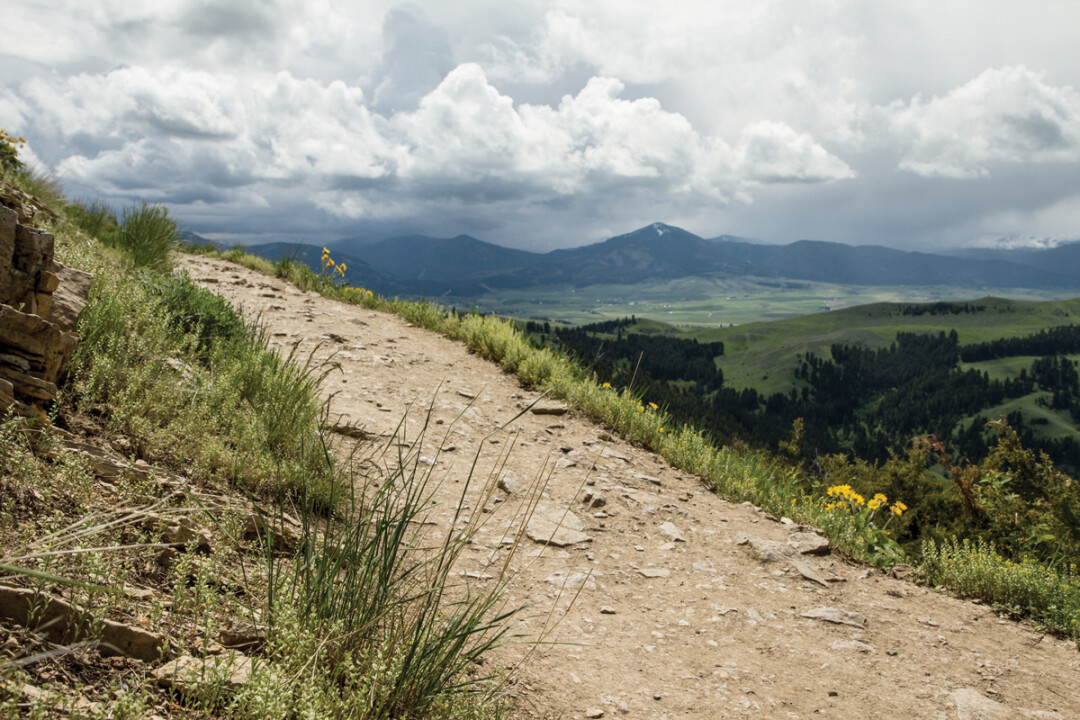
Written by Terry Cunningham.
